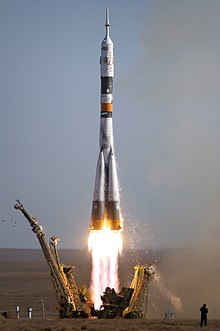Our website is made possible by displaying online advertisements to our visitors.
Please consider supporting us by disabling your ad blocker.
Soyuz (rocket family)
 A Soyuz-FG rocket carrying the Soyuz TMA-9 spacecraft launches from Baikonur Cosmodrome, Kazakhstan on 18 September 2006. | |
| Function | Medium-lift launch vehicle |
|---|---|
| Manufacturer | RKT Progress |
| Country of origin | Soviet Union · Russia |
| Size | |
| Stages | 3 |
| Associated rockets | |
| Family | R-7 |
| Launch history | |
| Status | Active |
| Launch sites | |
| First flight | 28 November 1966 |
| Type of passengers/cargo | Soyuz Progress |
Soyuz (Russian: Союз, lit. 'union', GRAU index: 11A511) is a family of Soviet and later Russian expendable medium-lift launch vehicles initially developed by the OKB-1 design bureau and manufactured by the Progress Rocket Space Centre factory in Samara, Russia. It holds the record for the most launches in the history of spaceflight. Soyuz rockets are part of the R-7 rocket family, which evolved from the R-7 Semyorka, the world's first intercontinental ballistic missile.
As with many Soviet rockets, the names of recurring payloads became associated with the launch vehicle itself. Consequently, the Soyuz rockets are best known as the launch vehicles for crewed Soyuz spacecraft under the Soyuz programme, as well as for uncrewed Progress cargo spacecraft to the International Space Station (ISS). Despite this recognition, the majority of Soyuz launches have been dedicated to deploying for satellites for both governmental and commercial purposes.
All variants of the Soyuz rocket use kerosene (RP-1) fuel and liquid oxygen (LOX), with the exception of the Soyuz-U2, which used Syntin (a variant of RP-1) with LOX.
From the final flight of the Space Shuttle program in 2011 until SpaceX's first crewed mission in 2020, Soyuz rockets were the only approved launch vehicles for transporting astronauts to the ISS.
Previous Page Next Page


